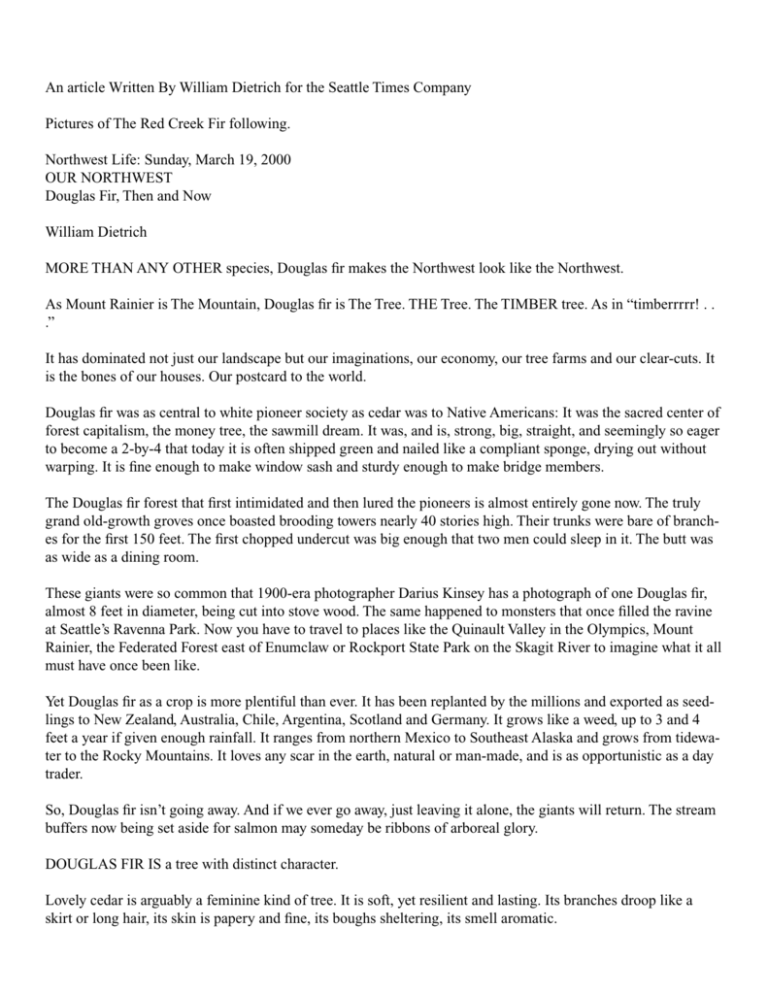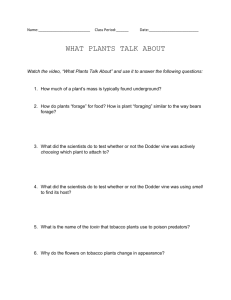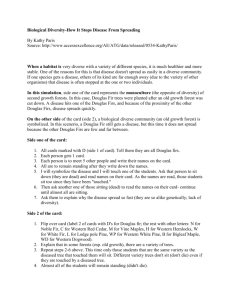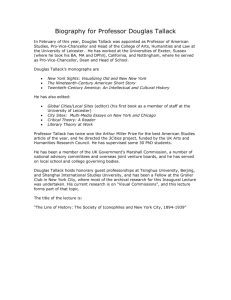
An article Written By William Dietrich for the Seattle Times Company
Pictures of The Red Creek Fir following.
Northwest Life: Sunday, March 19, 2000
OUR NORTHWEST
Douglas Fir, Then and Now
William Dietrich
MORE THAN ANY OTHER species, Douglas fir makes the Northwest look like the Northwest.
As Mount Rainier is The Mountain, Douglas fir is The Tree. THE Tree. The TIMBER tree. As in “timberrrrr! . .
.”
It has dominated not just our landscape but our imaginations, our economy, our tree farms and our clear-cuts. It
is the bones of our houses. Our postcard to the world.
Douglas fir was as central to white pioneer society as cedar was to Native Americans: It was the sacred center of
forest capitalism, the money tree, the sawmill dream. It was, and is, strong, big, straight, and seemingly so eager
to become a 2-by-4 that today it is often shipped green and nailed like a compliant sponge, drying out without
warping. It is fine enough to make window sash and sturdy enough to make bridge members.
The Douglas fir forest that first intimidated and then lured the pioneers is almost entirely gone now. The truly
grand old-growth groves once boasted brooding towers nearly 40 stories high. Their trunks were bare of branches for the first 150 feet. The first chopped undercut was big enough that two men could sleep in it. The butt was
as wide as a dining room.
These giants were so common that 1900-era photographer Darius Kinsey has a photograph of one Douglas fir,
almost 8 feet in diameter, being cut into stove wood. The same happened to monsters that once filled the ravine
at Seattle’s Ravenna Park. Now you have to travel to places like the Quinault Valley in the Olympics, Mount
Rainier, the Federated Forest east of Enumclaw or Rockport State Park on the Skagit River to imagine what it all
must have once been like.
Yet Douglas fir as a crop is more plentiful than ever. It has been replanted by the millions and exported as seedlings to New Zealand, Australia, Chile, Argentina, Scotland and Germany. It grows like a weed, up to 3 and 4
feet a year if given enough rainfall. It ranges from northern Mexico to Southeast Alaska and grows from tidewater to the Rocky Mountains. It loves any scar in the earth, natural or man-made, and is as opportunistic as a day
trader.
So, Douglas fir isn’t going away. And if we ever go away, just leaving it alone, the giants will return. The stream
buffers now being set aside for salmon may someday be ribbons of arboreal glory.
DOUGLAS FIR IS a tree with distinct character.
Lovely cedar is arguably a feminine kind of tree. It is soft, yet resilient and lasting. Its branches droop like a
skirt or long hair, its skin is papery and fine, its boughs sheltering, its smell aromatic.
Douglas fir is the masculine counterpoint. Its branches are upright and bristly, its bark is thick and wrinkled, its
height and girth are dominating.
Douglas fir breaks easily but heals its wounds. It is the infantry squad of an old World War II movie. On a
stormy coast it will twist and sculpt itself from a thousand indignities and come out gnarled and more spectacular. Twenty percent to 50 percent of its mass is underground and sometimes its roots will reach out and join the
roots of a cut or shattered stump. The buddy trees will keep the stump alive for hundreds of years, its top scabbing over with bark and its growth continuing.
Yet there is a mystery about why this tree is here at all.
The conifers that dominate our Northwest are dinosaur trees, species that appeared before the great reptiles. In
the tropics, Europe, the Eastern United States and Canada, needle-leaf conifers have mostly gone the way of the
dinosaurs, replaced by newer, more efficient leafy deciduous trees.
The West is weird. Our wet winters and dry summers favor evergreen trees that can photosynthesize year-round.
Winter rains allow our conifers to grow so tall, and natural resistance to fire, drought, disease and insects allows
them to live so long, that they out-top and outlast any leaf tree.
Yet Douglas fir is not the climax tree of our forests. It does not germinate well in full shade and so shade-tolerant hemlock and cedar will grow up under it and eventually replace it. Why did pioneers, then, find so many
Douglas firs in virgin forest?
One answer is fire, said James Agee, a forestry professor and fire expert at the University of Washington. Scientists have found evidence of huge fires here 300, 500 and 750 years ago. Douglas fir seeded in, outgrew competing hemlock, and lived so long that it dominated until whites arrived. The trees can routinely live for 500 to 700
years and if not burned or blown or cut, can exceed a millennium. One reached a recorded age of 1,400 years.
(Douglas fir today is more like lamb or veal, allowed to grow only 50 years on tree farms before being snipped
down.)
Yet there may also be an element of luck in the predominance of fir, said Agee’s colleague, Jerry Franklin. UW
professor Linda Brubaker has studied ancient pollen and discovered this region was dominated by different
trees, such as pine, in earlier interglacial periods. It may be that pockets of Douglas fir survived the last Ice Age,
established their dominance during unpredictable events such as drought and fire, and never gave it up, Franklin
said. Empires, careers and marriages can be the result of chance as well.
The result was that the greatest forest in the world was found on the American and Canadian west coasts, with a
volume of wood two to four times that of tropical rain forests.
DOUGLAS FIR is a hyphenated name in U.S. Forest Service usage - that is, Douglas-fir - because it is not a true
fir at all, instead being a species unique to the north Pacific Rim. The kind we’re familiar with has six cousins:
one in California, one in Japan and four in Siberia. The scientific name is Pseudo (or false) tsuga (hemlock)
menziesii, named for Archibald Menzies, the Scottish naturalist who accompanied explorer George Vancouver
and described the tree.
The Douglas of its common name comes from David Douglas, who sailed to Fort Vancouver on the Columbia
River in 1825 and over the next two years walked an astonishing 6,000 miles back and forth across the Northwest. The naturalist - the Indians called him “grass man” - collected scores of plants but was particularly as-
tounded by our regional giant. He marveled at trees 48 feet around, and also recorded tight “dog-hair” groves of
close-packed fir only 18 inches in diameter.
Its value as strong, easily cut and nailed lumber was soon discovered. Douglas fir drew timber tycoons like
Frederick Weyerhaeuser and built and rebuilt San Francisco, which was in the habit of burning down or being
leveled by earthquakes.
There was so much fir, and it was such a supreme lumber wood, that hemlock and cedar were treated as trash
trees. Rivers were choked with cut logs and filled with so much sawdust that a floating blanket of it sometimes
greeted sea travelers miles from the mouth of the Columbia River.
Its value has only grown. The recent battle over old growth was in part a battle over billions of dollars. Forest
Service researcher Tom Spies said a single acre of old-growth Douglas fir can be worth $30,000 as raw logs and
can build five to 10 houses. Protests saved millions of acres of trees.
NORTHWESTERNERS drool over tree champions the way Texans boast about ranch size, and our size expert
is Robert Van Pelt, another UW forest researcher who is Washington State Big Tree Program Coordinator. His
books include “Champion Trees of Washington State” and the upcoming “Forest Giants of the Pacific Coast,”
due later this year.
So just how big do Doug firs get, Bob?
There are claims of trees reaching 415 feet in height and 18 feet in diameter, he said, but the largest ever officially recorded in this state was the 1,020-year-old Mineral tree near Mount Rainier, which was 15.4 feet in
diameter and stood 393 feet tall before its top blew off. The entire tree blew down in 1930.
Of today’s top 10 Douglas firs, eight are in Washington. (Take that, Oregon, which beat us to the punch and
claimed Douglas fir as its state tree. Washington makes do with the doughty hemlock.) The tallest fir currently
known is 302-foot Quinault Rex on the west side of the Olympics. The biggest around, at 50 feet in circumference and 15.9 feet in diameter, is the nearby Queets fir. Biggest in volume is one near Port Renfrew, B.C., with
12,318 cubic feet of wood.
“Historically, the Quinault area is not that unusual when compared to other places in the Washington and Oregon coast ranges,” Van Pelt said. “What is unusual is that it is nearly the only place of this caliber that has not
been logged.” In other words, there were Douglas firs that were bigger or older, but they’ve been lost to the saw
or to wind.
A single big Douglas fir can have millions of needles totaling 1.5 acres in surface area; its fire-resistant bark can
be up to a foot thick. While many trees tend to stop growing higher after several decades, Douglas fir will keep
adding height and girth for centuries.
Compared to a human life, a Douglas fir operates in slow motion. Its complex seed cycle works well only about
every seven years, so there are long periods when it isn’t doing much reproducing. Even Douglas-fir dangers are
slow-paced. Before modern settlement, catastrophic fires might occur several centuries apart. A fungus called
root rot can topple a tree, but it may take hundreds of years to triumph. Bark-beetle populations occasionally
explode but, again, at long intervals: The last two in the western Cascades were in 1950 and 1993.
The longest-lived Douglas firs tend to be those on harsh, arid ridges where fungus doesn’t reach and fires are
rare.
THE BIOLOGY OF THE TREE, like all trees, is fascinating. Any house in these parts is apt to contain Douglas
fir and this sheltering envelope is a construction of carbon dioxide, water and sunlight. In a sense, your home is
made of air.
Half the weight of a Douglas fir can be water - moisture carried up hundreds of feet by the tension bond of water
molecules sucked skyward to replace those evaporating or being used for photosynthesis. Plants use only a trace
of minerals to grow but they take carbon-dioxide gas out of the air, water from the ground, and convert them to
sugars at the rate of 150 billion tons a year - a sugar that can be thought of as solar energy chemically fixed in
place. Oxygen is released in this manufacturing process, and the entire animal food chain ultimately relies on
these sugars to eat. When optimists say, “Life is sweet,” they aren’t exaggerating.
Left in the atmosphere, carbon dioxide is a greenhouse gas. By absorbing carbon dioxide, retaining the carbon
and releasing oxygen, plants counteract global warming. Some scientists have argued that logging may combat
global warming by locking up some carbon as lumber and plywood and soaking up more as young, fast-growing
trees replace what is milled. Old growth, they suggest, rots as fast as it grows, and thus doesn’t help.
Franklin, however, said new studies being conducted from a gigantic crane in Washington’s southern Cascades
are finding that old-growth forests actually are still absorbing excess carbon and thus are a valuable carbon
“sink” if left alone.
Douglas fir is much more than a gas sponge, of course. Van Pelt calls it “the most architecturally complex” tree
in our forests because of its huge size, fat branches and tendency to break and regrow, producing all kinds of interesting platforms for mosses, lichens, small mammals, birds and insects. The red-tree vole, a small mouse-like
mammal, dines primarily on fir needles, making it the most highly specialized vole in the world.
Because of their “just-right” level of rot resistance, dead fir snags also tend to make ideal habitat for critters.
They are easy enough to chew into but not so soft, like hemlock, that they blow over right away.
A tree is like an apartment building. “Going up that crane feels like you’re going to a different ecosystem,”
Spies describes, “like rising from the bottom of the ocean to the top.” As the forest matrix gets sunnier, windier
and drier near the top, the plants and animals occupying it change.
Douglas fir’s cellular structure makes it ideal lumber, explained Steve Ingram, director of marketing of western lumber for Weyerhaeuser. It is strong enough to be used in big pieces. A 237-foot log was once shipped to
London as a flagpole. The Tacoma Dome beams were built of Douglas fir salvaged from the volcanic blowdown
of Mount St. Helens. When Bill Gates built his house on Lake Washington his designers turned to gigantic salvaged beams of Douglas fir and re-milled them.
“It’s the best species on the planet in terms of its quality,” said Stan Floyd, a Weyerhaeuser research scientist
who guides the replanting of the company’s 1.5 million acres in Washington.
The familiar rings in a tree trunk are formed by different summer and winter growth cycles, and in most trees
the winter wood is inferior. Not so in Douglas fir.
Historically the tree was first in the world in total timber value, though the end of the old-growth bonanza has
allowed pine to challenge it. Even today Douglas fir is the tree of choice for structural lumber and for plywood.
It is a common Christmas tree.
As a result tree plantations in Washington are replanted primarily with Douglas fir, with some hemlock and ce-
dar seeding in naturally. Weyerhaeuser cuts its trees after 50 years, harvesting 2 percent of its land per year. That
rotation makes economic sense, but left to themselves the trees could live 10 times as long as they do.
Douglas fir survives and thrives in the full sunlight of a logging clear-cut that would bake other conifers - an
unfortunate bit of biology that has encouraged the clear-cutting that gives many of our hills their patchwork
look. New regulations are leaving wider buffers of uncut trees along streams, however, and shrinking individual
swaths of logging. Plum Creek Timber Co. is moving away from clear-cutting, experimenting with leaving strips
and clumps of trees behind. Canada’s MacMillan-Bloedel - recently acquired by Weyerhaeuser - is doing likewise. Franklin hopes the Canadian company infects its new parent with reform.
IF DOUGLAS FIR weren’t such a splendid wood tree, our Northwest would look very different. On the one
hand, it would not be so heavily cut. On the other, Douglas fir makes forest land so valuable that it helps corral
suburban sprawl. The tree’s worth both dooms and preserves our forests.
For native Northwesterners, it is the tree that says home. A million kids have played in and around Douglas
fir. Its bark has the roughness of a grizzled grandfather and its pitch is as sticky as candy. It is the sentinel of
our parks. Campfire smoke drifts through its pillars like incense in a cathedral. Its needles turn the ground into
spongy carpet. Douglas squirrels dismantle its cones like an ear of corn, loudly scolding any who get too close.
At the turn of the millennium, we live in a wistful hiatus. The biggest and best trees are long gone, sawed into
houses. Their descendants are rising in park land and new preserves. Centuries from now we’ll be forgotten but
those same trees, barely of middle age, will be waiting for our great-great-great-grandchildren.
And what grand beauties they’ll be.
William Dietrich, author and former Seattle Times reporter, writes Our Northwest for Pacific Northwest magazine. Benjamin Benschneider is staff photographer for the magazine. Paul Schmid is a Times news artist.
Forest Giants
Douglas squirrel
The Douglas squirrel is small, active and noisy when an intruder enters its territory in conifer forests west of the
Cascades in Oregon and Washington, and in southwestern B.C. and Northern California. It can strip a Douglas
fir cone like an ear of corn to get at the seeds. It will happily eat pine and spruce seeds, as well.
Western red cedar
100 to 175 feet tall
Flattened, scale-like needles
Clustered, half-inch-long cones
Western hemlock
100 to 150 feet tall
Short, flattened needles growing in two rows
3/4-inch to inch-long cones
Douglas fir
80 to 200 feet tall
Flattened needles 3/4 to 1 1/4-inch long, in two rows
Narrowly egg-shaped cones up to 3 inches long. Beneath each thin, rounded scale is a protruding three-pointed
bract - something that is the subject of a Native American legend. The story goes that during a forest fire mice
hid in fire-resistant Douglas firs for protection and to this day their feet and tails can been seen protruding from
the cones.
One Tall Tree
‘Most of the giant old-growth Douglas firs are long gone, claimed by logging. The tallest recorded Northwest
tree was a 393-footer near Mount Rainier. To visualize that height, consider the 605-foot Space Needle.
Copyright (c) 2000 Seattle Times Company, All Rights Reserved.
The Red Creek Fir
The Largest Fir Tree in the World
Maintained and Cared forby the People of Port Renfrew









